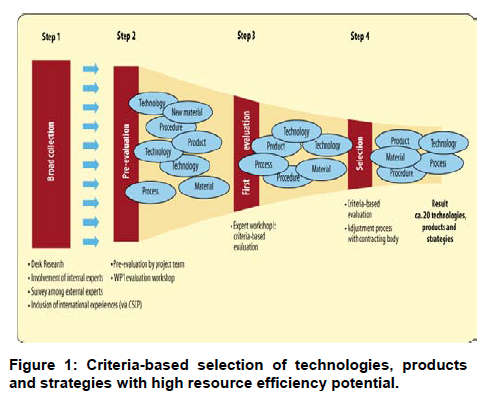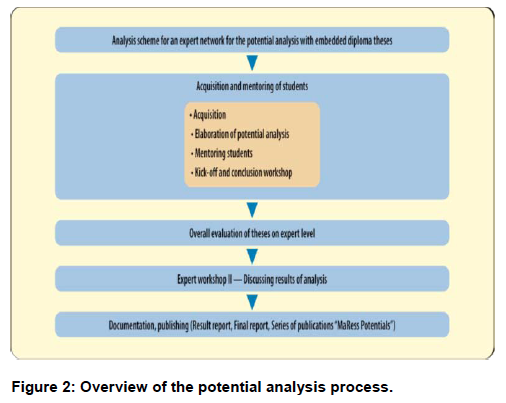In order to successfully provide relevant groups with political support for implementing resource efficiency, one needs to know where to start best, thus, where the highest potentials are likely to be found. Addressing four key issues, MaRess identified potentials for increasing resource efficiency, developed target group-specific resource efficiency policies, gained new insights into the effects of policy instruments at the macro- and micro-economic level, provided scientific support for implementation activities, engaged in agenda setting and communicated findings to specific target groups. This paper presents the overall results of Work Package 1 (WP1) with regard to the potential analyses of the identified technologies, products and strategies. The results were gained from research conducted in the context of a graduate research programme, which was embedded in a network of experts who were involved in the analysis.
The Starting Point
The extraction and exploitation of resources, the associated emissions and the disposal of waste are polluting the environment. The increasing scarcity of resources and the high and fluctuating prices of raw materials can lead to major economic and social dislocations, combined with a growing risk of conflicts over raw materials. Competitive disadvantages arising from the inefficient use of resources endanger the development of businesses and jobs. A strategy for increasing resource efficiency can limit all these problems, which is why this subject is increasingly becoming a key issue in national and international politics. As yet, however, consistent strategies and approaches for a successful resource efficiency policy have been lacking.
Against this background, the German Federal Environment Ministry and the Federal Environment Agency commissioned thirty-one project partners, under the direction of the Wuppertal Institute, to carry out the research project Material Efficiency and Resource Conservation (MaRess, project number 3707 93 300, duration 2007 to 2010).
The project aimed at advancing knowledge with respect to central questions of resource conservation, especially the increase of resource efficiency with a focus on material efficiency. Therefore, the most interesting technologies, products and strategies for increasing resource efficiency were identified in a broad, multi-staged, expert-driven process. After that, their concrete saving potential was determined. The potential analyses were carried out as part of a graduate research programme in the wider context of an expert network and expert-based analytical process. After their finalisation, the results of the single potential analyses were analysed in an intense discourse and cross-evaluation process. Finally, issue-specific as well as overarching recommendations for action were concluded.
Identifying Topics with High Resource Efficiency for Germany
Selection of Topics
The process of topic selection aimed at identifying technologies, products and strategies that are expected to carry high resource efficiency potential in Germany. In this respect, a complex expert-based methodology for evaluation and selection was developed that included four steps:
Step 1 “Broad collection”: Identifying topics via desk research and surveys.
Step 2 “Pre-evaluation”: Evaluation of about 1,000 proposals by three criteria: resource input, resource efficiency potential and economic relevance to end up with a focussed topic list (“Top 250 topics”)
Step 3 “First evaluation”: Expert evaluation along seven criteria: resource input in terms of mass relevance, resource efficiency potential of the specific application, other environmental impacts, feasibility, economic relevance, communicability and transferability.
Step 4 “Selection”: The final selection of the “Top 20 topics” was carried out in cooperation with the German Federal Environment Agency.

Potential Analysis as Part of a Graduate Research Programme
Altogether, potential analyses were performed with reference to 20 relevant topics (“Top 20 topics“), which are expected to carry high resource efficiency potential. Methodologically, the resource efficiency potentials were quantified according to the concept “Material Input per Unit of Service (MIPS). Therefore, the potential analyses are based on resource use across the whole life cycle for up to five resource categories. They determine the concrete potential for increasing resource efficiency in each case. Besides the assessment along quantitative results, a qualitative evaluation was carried out to capture, among other things, possible rebound effects and constraints to the dissemination of the application. The qualitative evaluations are based on publications, statistics and expert opinions.
After the finalisation of the potential analyses carried out by the students, the advisors pre-evaluated the theses. Furthermore, an internal evaluation workshop was held to assess the pre-evaluated potential analyses of the WP1 partners according to the seven criteria outlined in Step 3 and the guidelines for potential analysis in an overarching frame. The results of each individual thesis were discussed and specific, overarching recommendations for action were concluded.

From Water Filtration to Resource Efficiency Business Models
Seven fields of action were worked out in the course of the criteria-based cross-evaluation in which central results and recommendations for action for the individual potential analyses were merged. Each field of action summarises several closely interrelated topics from the potential analyses. The selective assignment of the topics is not always possible and there are complex interdependencies between the individual fields of action. Table 1 gives and overview of the fields of action and the potential analyses:
| Fields of action and assigned potential analyses |
| Cross-sectional technologies and enabling technologies: “Door openers” for resource efficient applications
Assessment of resource efficiency in grey water filtration using membrane technologies Resource-efficient energy storage: comparison of direct and indirect storage for electric vehicles Resource efficiency potential of energy storage – resource-efficient heat storage Resource efficiency potential of insulation material systems |
| Renewable energies facilitate substantial resource savings
Resource efficiency potential of wind and biomass power Resource-efficient large-scale energy production: potentials of Desertec Resource-efficient energy production by photovoltaics |
| The growing ICT market needs a careful resource management
Green IT: resource efficiency potential of server-based computing Green IT: resource efficiency increase with ICT – comparison of displays Resource efficiency potential of recycling small electric and electronic appliances by recoverage from household waste using radio frequency identification (RFID) labelling of primary products |
| Food – both production and consumption need to be considered
Resource efficiency potential in food production – example: fish Resource efficiency potential in food production – example: fruit Resource efficiency potential in food production – example: vegetables Resource efficiency potential of intelligent agricultural technologies in the example of the use of nitrogen sensors for fertilization |
| Traffic – infrastructure bears higher resource efficiency potential than drive systems
Assessment of resource efficiency potential in freight traffic Resource efficiency potential of electric vehicles |
| Integrating resource efficiency into product development
Consideration of resource efficiency criteria in product development processes Resource efficiency potential of implementing light-weight construction using new materials Resource efficiency potential of high-strength steel |
| Resource efficiency-oriented business models: product-service systems require rethinking
Resource efficiency potentials of new forms of “using instead of possessing” in assembly facilities Resource efficiency potential of production on demand |
Tab. 1: Overview of fields of action and potential analyses
Stronger Networking among Potential Partners and Early Industry Involvement
The topics worked on (“Top 20“) ought to be understood as the beginning of a systematic and encompassing analysis of resource efficiency potentials concerning our social and economic activities. Even though representing central and resource intensive sectors, the topics analysed naturally represent only a small selection from the totality of relevant topics and those that were identified and pre-assessed by the experts during the first expert workshop. Furthermore, some questions remain open and new questions were raised with regard to the topics addressed. Moreover, those topics presented in the expert workshop but not chosen for further analysis and those chosen at the workshop (“Top 50“) bear promising potential, which ought to be analysed in the future. There is also a need to study focus areas based on further case studies (e.g. central fields such as construction, living or food and nutrition).
The analyses also demonstrate the need to make greater use of or develop suitable arrangements (such as networks) to involve industrial partners at an early stage. On the one hand, the existing network of the MaRess project needs to be strengthened; on the other hand, further forms and consortia need to be established (e.g. with a stronger focus on sector-specific topics). This aims at ensuring that the project stays in touch with matters of implementation and feasibility regarding the potentials analysed.
Due to the broad range of topics and the possibilities for increasing resource efficiency in diverse sectors, the network of universities integrating the paradigm of resource efficiency in research and training ought to be expanded considerably. It would also be desirable to extend the circle of participating universities.
The Virtual Resource University
So far, in university education, only few departments and specialist areas offer programmes (e.g., lectures, seminars, projects) in the field of resource efficiency. Therefore, there is much room for increasing the number of programmes offered while they also need to be better integrated into existing curricula. To foster the broad integration of resource efficiency into university training and research, activities for the establishment of a “Virtual Resource University” (from innovation to implementation research) need to be started.
The results of the project will be documented in a comprehensive form in a final report and the central results are planned to be published in a book. Besides, the results of WP1 will be made use of in other work packages of the MaRess project and in the Network Resource Efficiency.
| Authors: | Dr. Kora Kristof kora.kristof@wupperinst.org
Holger Rohn holger.rohn@trifolium.org Nico Pastewski nico.pastewski@iao.fraunhofer.de |
|||||||
| Sponsors: | German Federal Environment Ministry
Federal Environment Agency |
|||||||
| Type: | National foresight exercise to increase resource efficiency and conserve resources. | |||||||
| Organizer: | Dr. Kora Kristof, Wuppertal Institute for Climate, Environment and Energy, D-42103 Wuppertal, Döppersberg 19, phone: +49 (0) 202 2492 -183, email: kora.kristof@wupperinst.org
Holger Rohn, Trifolium – Beratungsgesellschaft mbH, D-61169 Friedberg, Alte Bahnhofstrasse 13, phone: +49 (0) 6031 68 754 63, fax: – 68, email: holger.rohn@trifolium.org Nico Pastewski, Fraunhofer-Institut für Arbeitswirtschaft und Organisation IAO, Nobelstr. 12, D-70569 Stuttgart, phone: +49 (0) 711 970 -2222, fax: -2287, email: nico.pastewski@iao.fraunhofer.de |
|||||||
| Duration: | 2007-2010 | Budget: | ca. 540,000€ | Time Horizon: | N/A | Date of Brief: | July 2011 | |
Download EFP Brief No. 213_Material Efficiency and Resource Conservation
Sources and References
For information and downloads on the MaRess project and its findings please visit: http://ressourcen.wupperinst.org